 W
WAn Airy beam, is a propagation invariant wave whose main intensity lobe propagates along a curved parabolic trajectory while being resilient to perturbations (self-healing).
 W
WAn amphidromic point, also called a tidal node, is a geographical location which has zero tidal amplitude for one harmonic constituent of the tide. The tidal range for that harmonic constituent increases with distance from this point.
 W
WThe Bloch–Siegert shift is a phenomenon in quantum physics that becomes important for driven two-level systems when the driving gets strong.
 W
WBranched flow refers to a phenomenon in wave dynamics, that produces a tree-like pattern involving successive mostly forward scattering events by smooth obstacles deflecting traveling rays or waves. Sudden and significant momentum or wavevector changes are absent, but accumulated small changes can lead to large momentum changes. The path of a single ray is less important than the environs around a ray, which rotate, compress, and stretch around in an area preserving way. Even more revealing are groups, or manifolds of neighboring rays extending over significant zones. Starting rays out from a point but varying their direction over a range, one to the next, or from different points along a line all with the same initial directions are examples of a manifold. Waves have analogous launching conditions, such as a point source spraying in many directions, or an extended plane wave heading on one direction. The ray bending or refraction leads to characteristic structure in phase space and nonuniform distributions in coordinate space that look somehow universal and resemble branches in trees or stream beds. The branches taken on non-obvious paths through the refracting landscape that are indirect and nonlocal results of terrain already traversed. For a given refracting landscape, the branches will look completely different depending on the initial manifold.
 W
WIn hydrodynamics, a clapotis is a non-breaking standing wave pattern, caused for example, by the reflection of a traveling surface wave train from a near vertical shoreline like a breakwater, seawall or steep cliff. The resulting clapotic wave does not travel horizontally, but has a fixed pattern of nodes and antinodes. These waves promote erosion at the toe of the wall, and can cause severe damage to shore structures. The term was coined in 1877 by French mathematician and physicist Joseph Valentin Boussinesq who called these waves 'le clapotis' meaning "the lapping".
 W
WIn physics, dephasing is a mechanism that recovers classical behaviour from a quantum system. It refers to the ways in which coherence caused by perturbation decays over time, and the system returns to the state before perturbation. It is an important effect in molecular and atomic spectroscopy, and in the condensed matter physics of mesoscopic devices.
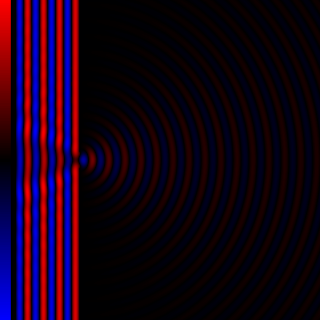 W
WDiffraction processes affecting waves are amenable to quantitative description and analysis. Such treatments are applied to a wave passing through one or more slits whose width is specified as a proportion of the wavelength. Numerical approximations may be used, including the Fresnel and Fraunhofer approximations.
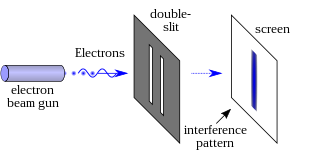 W
WIn modern physics, the double-slit experiment is a demonstration that light and matter can display characteristics of both classically defined waves and particles; moreover, it displays the fundamentally probabilistic nature of quantum mechanical phenomena. This type of experiment was first performed, using light, by Thomas Young in 1801, as a demonstration of the wave behavior of light. At that time it was thought that light consisted of either waves or particles. With the beginning of modern physics, about a hundred years later, it was realized that light could in fact show behavior characteristic of both waves and particles. In 1927, Davisson and Germer demonstrated that electrons show the same behavior, which was later extended to atoms and molecules. Thomas Young's experiment with light was part of classical physics well before quantum mechanics, and the concept of wave-particle duality. He believed it demonstrated that the wave theory of light was correct, and his experiment is sometimes referred to as Young's experiment or Young's slits.
 W
WElectromagnetically induced transparency (EIT) is a coherent optical nonlinearity which renders a medium transparent within a narrow spectral range around an absorption line. Extreme dispersion is also created within this transparency "window" which leads to "slow light", described below. It is in essence a quantum interference effect that permits the propagation of light through an otherwise opaque atomic medium.
 W
WIn estimation theory, estimation of signal parameters via rotational invariant techniques (ESPRIT) is a technique to determine parameters of a mixture of sinusoids in a background noise. This technique is first proposed for frequency estimation, however, with the introduction of phased-array systems in daily use technology, it is also used for Angle of arrival estimations as well.
 W
WIn interferometry experiments such as the Michelson–Morley experiment, a fringe shift is the behavior of a pattern of “fringes” when the phase relationship between the component sources change.
 W
WThe group velocity of a wave is the velocity with which the overall envelope shape of the wave's amplitudes—known as the modulation or envelope of the wave—propagates through space.
 W
WThe Huygens–Fresnel principle is a method of analysis applied to problems of wave propagation both in the far-field limit and in near-field diffraction and also reflection. It states that every point on a wavefront is itself the source of spherical wavelets, and the secondary wavelets emanating from different points mutually interfere. The sum of these spherical wavelets forms the wavefront.
 W
WA hydraulic jump is a phenomenon in the science of hydraulics which is frequently observed in open channel flow such as rivers and spillways. When liquid at high velocity discharges into a zone of lower velocity, a rather abrupt rise occurs in the liquid surface. The rapidly flowing liquid is abruptly slowed and increases in height, converting some of the flow's initial kinetic energy into an increase in potential energy, with some energy irreversibly lost through turbulence to heat. In an open channel flow, this manifests as the fast flow rapidly slowing and piling up on top of itself similar to how a shockwave forms.
 W
WIn physics, interference is a phenomenon in which two waves superpose to form a resultant wave of greater, lower, or the same amplitude. Constructive and destructive interference result from the interaction of waves that are correlated or coherent with each other, either because they come from the same source or because they have the same or nearly the same frequency. Interference effects can be observed with all types of waves, for example, light, radio, acoustic, surface water waves, gravity waves, or matter waves. The resulting images or graphs are called interferograms.
 W
WLamb waves propagate in solid plates or spheres. They are elastic waves whose particle motion lies in the plane that contains the direction of wave propagation and the plane normal. In 1917, the English mathematician Horace Lamb published his classic analysis and description of acoustic waves of this type. Their properties turned out to be quite complex. An infinite medium supports just two wave modes traveling at unique velocities; but plates support two infinite sets of Lamb wave modes, whose velocities depend on the relationship between wavelength and plate thickness.
 W
WA longitudinal mode of a resonant cavity is a particular standing wave pattern formed by waves confined in the cavity. The longitudinal modes correspond to the wavelengths of the wave which are reinforced by constructive interference after many reflections from the cavity's reflecting surfaces. All other wavelengths are suppressed by destructive interference.
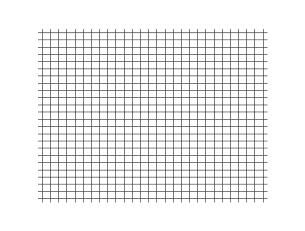 W
WLongitudinal waves are waves in which the displacement of the medium is in the same direction as, or the opposite direction to, the direction of propagation of the wave. Mechanical longitudinal waves are also called compressional or compression waves, because they produce compression and rarefaction when traveling through a medium, and pressure waves, because they produce increases and decreases in pressure.
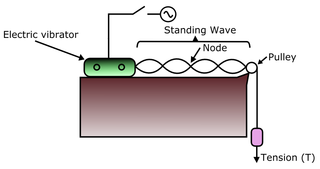 W
WMelde's experiment is a scientific experiment carried out in 1859 by the German physicist Franz Melde on the standing waves produced in a tense cable originally set oscillating by a tuning fork, later improved with connection to an electric vibrator. This experiment, "a lecture-room standby", attempted to demonstrate that mechanical waves undergo interference phenomena. In the experiment, mechanical waves traveled in opposite directions form immobile points, called nodes. These waves were called standing waves by Melde since the position of the nodes and loops stayed static.
 W
WModal testing is the form of vibration testing of an object whereby the natural (modal) frequencies, modal masses, modal damping ratios and mode shapes of the object under test are determined.
 W
WIn physics, a nonlinear X-wave (NLX) is a multi-dimensional wave that can travel without distortion.
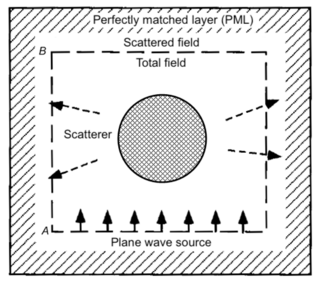 W
WA perfectly matched layer (PML) is an artificial absorbing layer for wave equations, commonly used to truncate computational regions in numerical methods to simulate problems with open boundaries, especially in the FDTD and FE methods. The key property of a PML that distinguishes it from an ordinary absorbing material is that it is designed so that waves incident upon the PML from a non-PML medium do not reflect at the interface—this property allows the PML to strongly absorb outgoing waves from the interior of a computational region without reflecting them back into the interior.
 W
WIn mathematics, a periodic travelling wave is a periodic function of one-dimensional space that moves with constant speed. Consequently, it is a special type of spatiotemporal oscillation that is a periodic function of both space and time.
 W
WIn physics and mathematics, the phase of a periodic function of some real variable is an angle representing the number of periods spanned by that variable. It is denoted and expressed in such a scale that it varies by one full turn as the variable goes through each period. It may be measured in any angular unit such as degrees or radians, thus increasing by 360° or as the variable completes a full period.
 W
WPhase Inversion when referring to sound acoustics, is incorrect terminology and is sometimes used incorrectly interchangeably to mean Polarity inversion. Polarity Inversion is the swapping of the two poles of an alternating current source. A polarity inversion is neither a time shift nor a phase shift, but simply a swap of plus and minus.
 W
WThe phase velocity of a wave is the rate at which the wave propagates in some medium. This is the velocity at which the phase of any one frequency component of the wave travels. For such a component, any given phase of the wave will appear to travel at the phase velocity. The phase velocity is given in terms of the wavelength λ (lambda) and time period T as
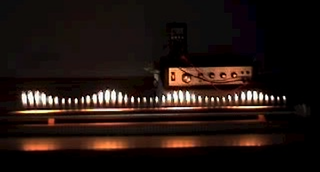 W
WA Rubens' tube, also known as a standing wave flame tube, or simply flame tube, is an antique physics apparatus for demonstrating acoustic standing waves in a tube. Invented by German physicist Heinrich Rubens in 1905, it graphically shows the relationship between sound waves and sound pressure, as a primitive oscilloscope. Today, it is used only occasionally, typically as a demonstration in physics education.
 W
WThe Schrödinger equation is a linear partial differential equation that governs the wave function of a quantum-mechanical system. It is a key result in quantum mechanics, and its discovery was a significant landmark in the development of the subject. The equation is named after Erwin Schrödinger, who postulated the equation in 1925, and published it in 1926, forming the basis for the work that resulted in his Nobel Prize in Physics in 1933.
 W
WShear wave splitting, also called seismic birefringence, is the phenomenon that occurs when a polarized shear wave enters an anisotropic medium. The incident shear wave splits into two polarized shear waves. Shear wave splitting is typically used as a tool for testing the anisotropy of an area of interest. These measurements reflect the degree of anisotropy and lead to a better understanding of the area's crack density and orientation or crystal alignment. We can think of the anisotropy of a particular area as a black box and the shear wave splitting measurements as a way of looking at what is in the box.
 W
WSidewinding is a type of locomotion unique to caenophidian snakes, used to move across loose or slippery substrates. It is most often used by the Saharan horned viper, Cerastes cerastes, the Mojave sidewinder rattlesnake, Crotalus cerastes, and the Namib desert sidewinding adder, Bitis peringueyi, to move across loose desert sands, and it is also used by Homalopsine snakes in Southeast Asia to move across tidal mud flats. Any number of caenophidian snakes can be induced to sidewind on smooth surfaces, though their difficulty in getting them to do so and their proficiency at it vary greatly.
 W
WA sine wave or sinusoid is a mathematical curve that describes a smooth periodic oscillation. A sine wave is a continuous wave. It is named after the function sine, of which it is the graph. It occurs often in both pure and applied mathematics, as well as physics, engineering, signal processing and many other fields. Its most basic form as a function of time (t) is:
 W
WIn mathematics and physics, a soliton or solitary wave is a self-reinforcing wave packet that maintains its shape while it propagates at a constant velocity. Solitons are caused by a cancellation of nonlinear and dispersive effects in the medium. Solitons are the solutions of a widespread class of weakly nonlinear dispersive partial differential equations describing physical systems.
 W
WIn physics, a standing wave, also known as a stationary wave, is a wave which oscillates in time but whose peak amplitude profile does not move in space. The peak amplitude of the wave oscillations at any point in space is constant with time, and the oscillations at different points throughout the wave are in phase. The locations at which the absolute value of the amplitude is minimum are called nodes, and the locations where the absolute value of the amplitude is maximum are called antinodes.
 W
WA tidal bore, often simply given as bore in context, is a tidal phenomenon in which the leading edge of the incoming tide forms a wave of water that travels up a river or narrow bay against the direction of the river or bay's current.
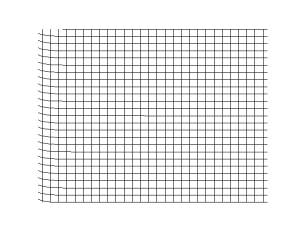 W
WIn physics, a transverse wave is a wave that vibrates perpendicular to the direction of the wave or path of propagation.
 W
WIn fluid dynamics, a trochoidal wave or Gerstner wave is an exact solution of the Euler equations for periodic surface gravity waves. It describes a progressive wave of permanent form on the surface of an incompressible fluid of infinite depth. The free surface of this wave solution is an inverted (upside-down) trochoid – with sharper crests and flat troughs. This wave solution was discovered by Gerstner in 1802, and rediscovered independently by Rankine in 1863.
 W
WTropical instability waves, often abbreviated TIW, are a phenomenon in which the interface between areas of warm and cold sea surface temperatures near the equator form a regular pattern of westward-propagating waves. These waves are often present in the Atlantic Ocean, extending westward from the African coast, but are more easily recognizable in the Pacific, extending westward from South America. They have an average period of about 30 days and wavelength of about 1100 kilometers, and are largest in amplitude between June and November. They are also largest during La Niña conditions, and may disappear when strong El Niño conditions are present.
 W
WUndulatory locomotion is the type of motion characterized by wave-like movement patterns that act to propel an animal forward. Examples of this type of gait include crawling in snakes, or swimming in the lamprey. Although this is typically the type of gait utilized by limbless animals, some creatures with limbs, such as the salamander, forgo use of their legs in certain environments and exhibit undulatory locomotion. In robotics this movement strategy is studied in order to create novel robotic devices capable of traversing a variety of environments.
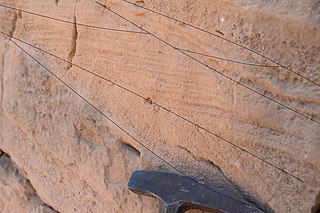 W
WUpper Shoreface refers to the portion of the seafloor that is shallow enough to be agitated by everyday wave action, the wave base.
 W
WThe wave base, in physical oceanography, is the maximum depth at which a water wave's passage causes significant water motion. At water depths deeper than the wave base, bottom sediments and the seafloor are no longer stirred by the wave motion above.
 W
WThe wave equation is an important second-order linear partial differential equation for the description of waves—as they occur in classical physics—such as mechanical waves or light waves. It arises in fields like acoustics, electromagnetics, and fluid dynamics.
 W
WA wave farm – or wave power farm or wave energy park – is a collection of machines in the same location and used for the generation of wave power electricity. Wave farms can be either offshore or nearshore, with the former the most promising for the production of large quantities of electricity for the grid. The first wave farm was constructed in Portugal, the Aguçadoura Wave Farm, consisting of three Pelamis machines. The world's largest is planned for Scotland.
 W
WIn physics, a wave packet is a short "burst" or "envelope" of localized wave action that travels as a unit. A wave packet can be analyzed into, or can be synthesized from, an infinite set of component sinusoidal waves of different wavenumbers, with phases and amplitudes such that they interfere constructively only over a small region of space, and destructively elsewhere. Each component wave function, and hence the wave packet, are solutions of a wave equation. Depending on the wave equation, the wave packet's profile may remain constant or it may change (dispersion) while propagating.
 W
WIn radio-frequency engineering and communications engineering, waveguide is a hollow metal pipe used to carry radio waves. This type of waveguide is used as a transmission line mostly at microwave frequencies, for such purposes as connecting microwave transmitters and receivers to their antennas, in equipment such as microwave ovens, radar sets, satellite communications, and microwave radio links.
 W
WIn the physical sciences, the wavenumber is the spatial frequency of a wave, measured in cycles per unit distance or radians per unit distance. Whereas temporal frequency can be thought of as the number of waves per unit time, wavenumber is the number of waves per unit distance.